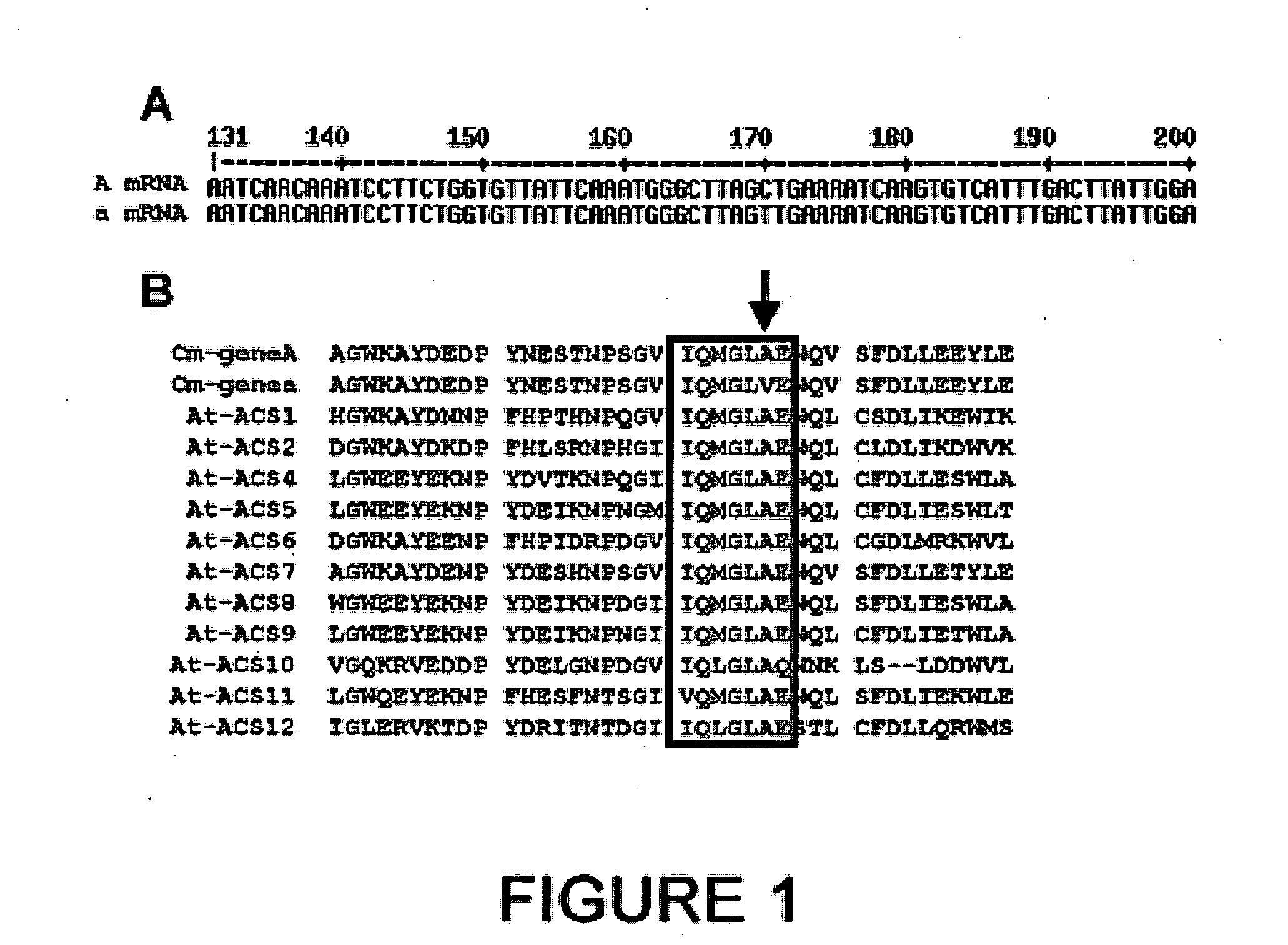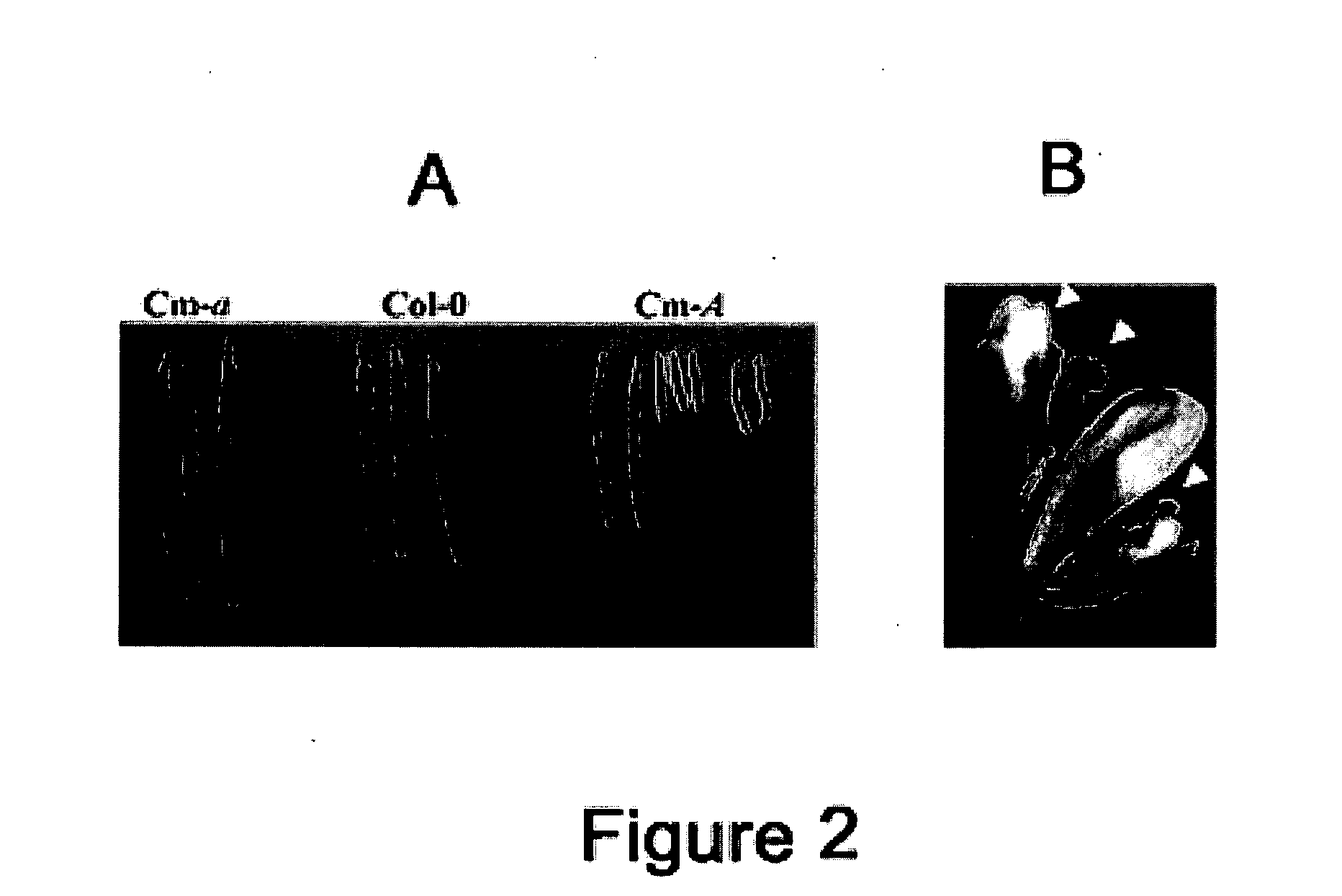Genetic system for controlling the floral development of a dicotyledon plant, and implementation in detection and selection processes
a dicotyledon plant and gene technology, applied in the field of plant varieties selection, can solve the problems of high cost of chemical agents, ineffective agents, and limited production of pure lines using such methods
- Summary
- Abstract
- Description
- Claims
- Application Information
AI Technical Summary
Benefits of technology
Problems solved by technology
Method used
Image
Examples
example 1
Identification of a Single Nucleotide Polymorphism (SNP)
[0432]The sequence analysis of a DNA fragment comprising the promoter of the gene (A / a) region (2 kb upstream from the initiation codon) reveals a high level of polymorphism in the regulatory region at 5′ and in the intron sequences, whereas only one occasional mutation in the protein coding sequence was identified (FIG. 1A). Such occasional mutation on the nucleic acid results as regards the ACCS protein polypeptide sequence in the replacement of an alanine residue at position 57 with a valine residue (FIG. 1B). By using methods for predicting amino acid substitutions, based on sequence and physical property homologies, it has been analyzed whether the occasional mutation identified in the allele a is harmful for the protein function.
[0433]The SIFT software (Ng PC and Henikoff S., 2001) does predict that Ala57Val substitution has a highly harmful effect on the function A. Moreover, crystalline structure analyses of ACC synthas...
example 2
Spatial and Temporal Expression of the Genetic Control Element (A / a)
[0436]To analyse the expression of the genetic control element A / a in the form of the allele A, in situ hybridizations were performed by using allele A -specific probes in plants, and more precisely in male, female and bisexual plant floral meristems, of genotype AA GG, aa GG, AA gg and aa gg. In the floral meristems A, the expression is locally high and the hybridization signal is specifically detected in the female and bisexual flower carpel primordia of monoecious, andromonoecious, gynoecious and hermaphroditic plants. Referring to the various flower development stages described for cucumber (Bai and al., 2004), it appears in melon that the gene (A / a) is expressed in an early stage of the floral meristem development, before a morphological distinction may be done between male and female flowers.
[0437]In male and hermaphroditic flowers, no expression could be detected in the anthers. These results indicate that ex...
example 3
Transgenesis in Arabidopsis thaliana
[0438]The possible effects of gene A / a and ACCS protein on the flower sex phenotype and the flower architecture in plants not belonging to cucurbitaceae have been studied by transforming Arabidopsis thaliana with Agrobacterium. Arabidopsis transgenic plants carrying the melon allele A or a have a phenotype at the floral architecture and siliqua level. (FIGS. 2A and 2B). Indeed siliqua of Arabidopsis transformants are shorter than those of a wild type Arabidopsis plant and the flower architecture of the Arabidopsis transformants is highly affected. These results enable to extend the use of the melon gene (A / a) to dicotyledon plants not belonging to the cucurbitaceae family.
PUM
| Property | Measurement | Unit |
|---|---|---|
| nucleic acid | aaaaa | aaaaa |
| resistance | aaaaa | aaaaa |
| flowering time | aaaaa | aaaaa |
Abstract
Description
Claims
Application Information
 Login to View More
Login to View More - R&D
- Intellectual Property
- Life Sciences
- Materials
- Tech Scout
- Unparalleled Data Quality
- Higher Quality Content
- 60% Fewer Hallucinations
Browse by: Latest US Patents, China's latest patents, Technical Efficacy Thesaurus, Application Domain, Technology Topic, Popular Technical Reports.
© 2025 PatSnap. All rights reserved.Legal|Privacy policy|Modern Slavery Act Transparency Statement|Sitemap|About US| Contact US: help@patsnap.com


